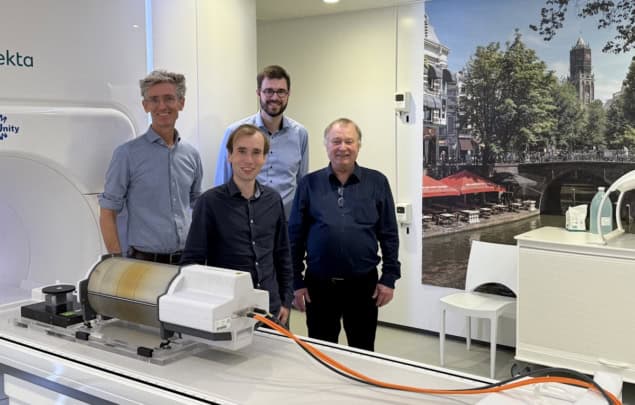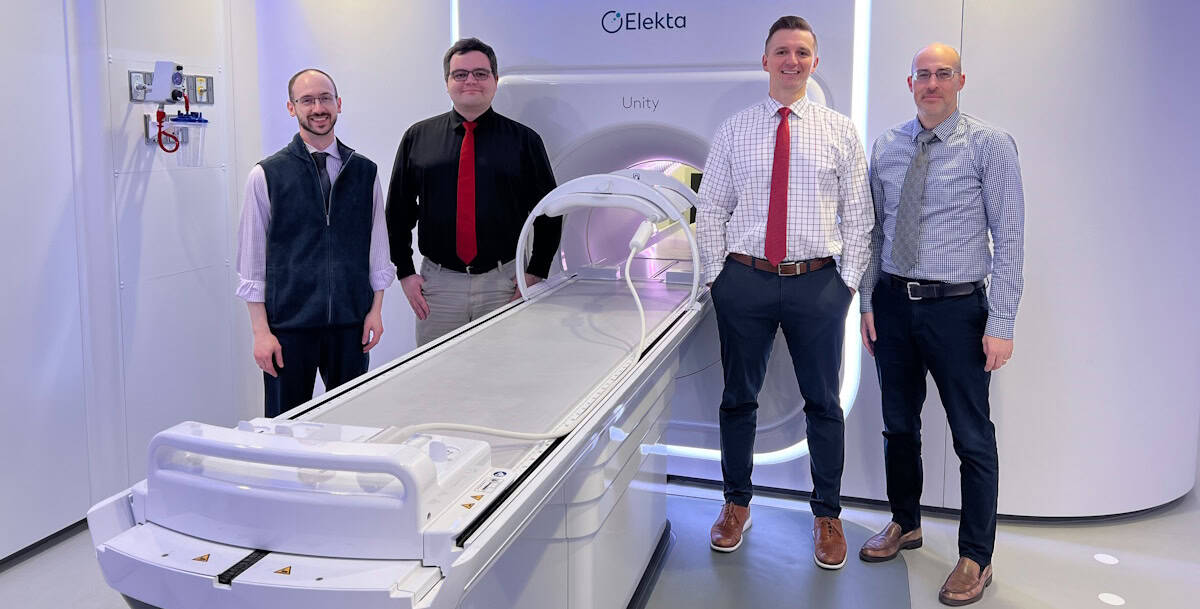
Researchers at the University of Iowa and University Medical Center Utrecht are working to incorporate volumetric-modulated arc therapy (VMAT) delivery capabilities into the MR-linac. They present the first dosimetric evaluation comparing VMAT and intensity-modulated radiation therapy (IMRT) on the MR-linac in the International Journal of Radiation Oncology, Biology, Physics.
“We’ve been doing MR-guided radiotherapy at the University of Iowa for about five and a half years now,” says senior author Daniel Hyer, a medical physicist and professor of radiation oncology at the University of Iowa. “We want to treat as many patients as possible in MR-guided radiotherapy and improve the access to technology, but we also want to do it efficiently so that we don’t have intra-fraction motion.”
MR-guided radiotherapy combines magnetic resonance imaging (MRI) with radiation therapy to treat cancer. By providing real-time images of internal organs during treatment, clinicians can more accurately target radiation to a tumour and spare healthy tissues.
MR-linacs in clinics today support IMRT, which delivers radiation in a “step-and-shoot” manner. For many treatment sites, VMAT is often preferred over IMRT. VMAT delivers radiation continuously through one or more arcs around a patient and has advantages in target coverage, organs-at-risk sparing, and planning and delivery times. To date, however, VMAT isn’t available on commercial MR-linacs.
Incorporating VMAT delivery into the MR-linac could improve plan quality and efficiency and reduce patient discomfort. Current MR-guided radiotherapy workflows require the patient to lie on the scanner bore throughout MR imaging, contour registration, plan optimization, dose checks and a verification scan prior to plan delivery, which can take over 20 min.
“VMAT is one of the top asks from physicians when it comes to desired – but currently missing – MR-linac functionality. The future availability of VMAT on the MR-linac will allow access to highly precise MRI-guided treatments for more patients,” says co-author Martin Fast, an associate professor at University Medical Center Utrecht.
In 2022, Fast’s group had shown that VMAT deliveries were possible on the Elekta Unity, a 1.5 T MR-linac; however, they lacked clinical-quality VMAT plans with fluence modulation. A serendipitous meeting helped both groups overcome hurdles in their research.

“Dan’s group and our group in Utrecht were independently working on MR-linac VMAT. Dan from the planning side, us from the delivery side,” Fast explains. “Dan’s limitation was that he couldn’t prove that his plans were deliverable, and we didn’t have the high-quality clinical-grade VMAT plans available for delivery. The collaboration started in July 2023 through a chance encounter in Houston, where Dan and I happened to present at the same session during an AAPM pre-meeting course.”
In their current study, the researchers demonstrated that VMAT deliveries are possible on Unity, without requiring changes to clinical hardware. The retrospective study showed that combined optimization and delivery time were shortened by up to 7.5 min compared with standard step-and-shoot IMRT.
“VMAT nearly doubles the delivery speed compared to conventional step-and-shoot IMRT, which means faster treatments (i.e., better patient comfort) and better accuracy (due to less chance for unexpected motion),” says Fast.

In collaboration with Elekta, the researchers developed a modified version of software that allowed them to deliver a VMAT-like plan with Unity. For 10 prostate cancer patients previously treated on a 1.5 T MR-linac, they replanned treatments to deliver to 36.25 Gy in five fractions, using three techniques: step-and-shoot IMRT and a clinical optimizer; the same optimizer with a VMAT technique; and a research-based optimizer with VMAT.
The plans were adapted onto MRI datasets using two optimization strategies to assess adapt-to-position planning. The team assessed plan quality by evaluating organs-at-risk sparing and evaluated treatment efficiency by measuring the optimization time, delivery time and total (optimization plus delivery) time. Delivery accuracy was assessed via a gamma analysis (2%/2 mm).
Results showed that optimization time plus delivery time yielded savings of up to 7.5 min for the VMAT optimization and the research-based optimizer with VMAT, compared with the clinical optimizer with IMRT. Adapt-to-position planning showed a similar reduction in total time. All VMAT plans had gamma passing rates greater than 96%, and the delivery efficiency of VMAT plans was nearly 90%, compared with 50% for clinical IMRT.

Scintillator array validates MRI-guided multileaf collimator tracking
“We’ve shown [that this technology] is feasible. We delivered it, we’ve done the quality assurance, we’ve made the plans. I think that is a huge milestone to pushing this towards clinical implementation. And there’s no major physics or technical hurdles that still need to be cleared – it’s mostly engineering…so that’s great news,” says Hyer.
Next steps for the researchers include providing physics guidance and quality assurance tests so that when VMAT becomes clinically available on MR-linacs, medical physicists have recommendations for implementation. They are also looking at VMAT for gated treatments, motion management strategies for VMAT deliveries, and other treatment sites.



